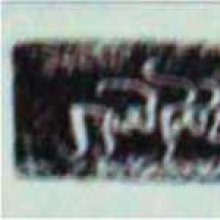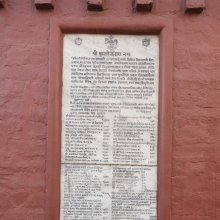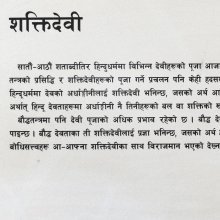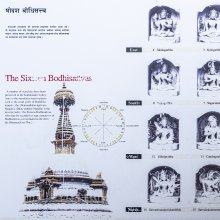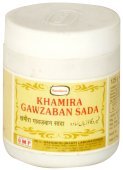Cata, Caṭa, Caṭā, Catā, Cāṭā, Cātā: 16 definitions
Introduction:
Cata means something in Hinduism, Sanskrit, the history of ancient India, Marathi, Hindi, biology, Tamil. If you want to know the exact meaning, history, etymology or English translation of this term then check out the descriptions on this page. Add your comment or reference to a book if you want to contribute to this summary article.
Alternative spellings of this word include Chata.
Images (photo gallery)
(+4 more images available)
India history and geography
Source: Cologne Digital Sanskrit Dictionaries: Indian Epigraphical GlossaryCāṭa.—(HD), irregular soldiers according to Fleet and Bühler. Vogel (Ant. Ch. St., pp. 130-32) points out that Chamba is the only place where the ancient word Cāṭa is still extant in the modern form Cād8 meaning ‘the head of a Parganā’. An important privilege of a gift village was ‘not to be entered by Cāṭas and Bhaṭas’. Inscriptions (Ep. Ind., Vol. XI, p. 221) often specify that the granted land was not to be entered by Cāṭas and Bhaṭas except for seizing robbers and those guilty of harm or treason to the king (cf. a-cāṭa-bhaṭa-praveśyaṃ cora- drohaka-varjam in op. cit., Vol. VIII, p. 287). Sometimes we have bhaṭa-cāṭa-sevaka-ādīn (Ep. Ind., Vol. IV, p. 211) and caṭṭa-bhaṭṭa-jātīyān janapadān (ibid., Vol. XIV, p. 160). (IE 8-3; CII 3, 4), generally mentioned along with bhaṭa; sometimes replaced by cāra (spy) and chātra (literally, ‘umbrella-bearer’, but really, a constable, i. e. a Pāik or Piāda); probably indicates the leader of a group of Bhaṭas, i. e. Pāiks and Piādas; a policeman leading a group of Pāiks. See caṭṭa. Yājñavalkya, I. 336, speaks of the duty of the king to protect people from the harassment caused by cāṭas, robbers and Kāyasthas and the Mitākṣarā explains cāṭa as persons who deprive people of their wealth after creating false confi- dence in them. According to Bṛhaspati quoted by Aparārka, ‘dangers common to all are those arising from the cāṭas and thieves’. The word cāṭa in the passage tārkika-cāṭa-bhaṭa-rāj- āpraveśya in Śaṅkara's Bhāsya on the Bṛhadāraṇyaka Upaniṣad is explained by Ānandagiri by saying that the cāṭas are those that transgress the rules of conduct for decent people and that bhaṭas are servants telling falschood (Ep. Ind., Vol. IX, p. 296). But cāṭa is used in inscriptions in the sense of a royal official. Note: cāṭa is defined in the “Indian epigraphical glossary” as it can be found on ancient inscriptions commonly written in Sanskrit, Prakrit or Dravidian languages.

The history of India traces the identification of countries, villages, towns and other regions of India, as well as mythology, zoology, royal dynasties, rulers, tribes, local festivities and traditions and regional languages. Ancient India enjoyed religious freedom and encourages the path of Dharma, a concept common to Buddhism, Hinduism, and Jainism.
Biology (plants and animals)
Source: Google Books: CRC World Dictionary (Regional names)Cata in Ethiopia is the name of a plant defined with Catha edulis in various botanical sources. This page contains potential references in Ayurveda, modern medicine, and other folk traditions or local practices It has the synonym Methyscophyllum glaucum Eckl. & Zeyh. (among others).
Example references for further research on medicinal uses or toxicity (see latin names for full list):
· Enchiridion Botanicum (1841)
· Symbolae Botanicae (1790)
· Species Plantarum (1753)
· Fitoterapia (1991)
· Flora AegyptiacoArabica (1775)
· A Voyage to Terra Australis (1814)
If you are looking for specific details regarding Cata, for example chemical composition, extract dosage, diet and recipes, pregnancy safety, side effects, health benefits, have a look at these references.

This sections includes definitions from the five kingdoms of living things: Animals, Plants, Fungi, Protists and Monera. It will include both the official binomial nomenclature (scientific names usually in Latin) as well as regional spellings and variants.
Languages of India and abroad
Marathi-English dictionary
Source: DDSA: The Molesworth Marathi and English Dictionarycaṭa (चट).—m S An image of darbha- grass at Shraddha when the required Brahman is not present; to represent him and to receive the homage due to him.
--- OR ---
caṭa (चट).—f (cāṭaṇēṃ To taste.) A taste, taking to, penchant; an acquired liking or fondness. 2 (cāṭaṇēṃ To lick.) A thin coating (of plaster, paint, whitewash &c.) v dē.
--- OR ---
caṭa (चट).—ad (Low. cāṭaṇēṃ To lick.) Wholly, altogether, clean, clear, smack and smooth. Ex. caṭa āmbē nāsalē; caṭa māṇasēṃ yātrēsa gēlīṃ.
--- OR ---
cāṭa (चाट).—a Light, low, scampish; of loose habits and practices; of blackguardly tricks or ways. Ex. hmaṇē pusasī vōṣṭha cāṭūni cāṭa || punhā bōlasī dhīṭa gōṣṭī || acāṭā &c. 2 (Or cāṭaḷa or cāvaṭa) Tediously talkative; addicted to prating: also given to blabbing.
--- OR ---
cāta (चात).—m f n The whirler of a spinning wheel: also the iron spike infixed, on which the thread is formed: also a separate pin or spindle. cāta as Whirler is larger than cātī, and is attached to the rāhaṭa or Wheel; whereas cātī may be a Circular plate separate and for the hand. 2 The iron saḷaī or pin of goldsmiths, to pierce holes. 3 A shell in general spindle-like, long, and spiral.
Source: DDSA: The Aryabhusan school dictionary, Marathi-Englishcaṭa (चट).—m An image or darbha grass at Shraddha when the required Brahman is not present to represent him and to receive the homage due to him.
--- OR ---
caṭa (चट).—f A taste, taking to, penchant; an acquired liking or fondness. A thin coating (of plaster, paint, whitewash &c.). v dē.
--- OR ---
caṭa (चट).—ad Wholly, altogether, clean, clear, smack and smooth.
--- OR ---
cāṭa (चाट).—a Light, low. Tediously talkative.
--- OR ---
cāta (चात).—mfn The whirler of a spinning wheel. The iron pin of goldsmiths.
Marathi is an Indo-European language having over 70 million native speakers people in (predominantly) Maharashtra India. Marathi, like many other Indo-Aryan languages, evolved from early forms of Prakrit, which itself is a subset of Sanskrit, one of the most ancient languages of the world.
Sanskrit dictionary
Source: DDSA: The practical Sanskrit-English dictionaryCāṭa (चाट).—[caṭ-bhede ac] A rogue or cheat, swindler, one who wins the confidence of the person he wishes to deceive; Y.1.336; (cāṭā = pratārakāḥ viśvāsya ye paradhanamapaharanti Mitā.); Pañcatantra (Bombay) 1.343.
Derivable forms: cāṭaḥ (चाटः).
Source: Cologne Digital Sanskrit Dictionaries: Shabda-Sagara Sanskrit-English DictionaryCāṭa (चाट).—m.
(-ṭaḥ) A cheat, a rogue, a peculator, one who makes away with money &c. entrusted to him. E. caṭ to injure, affix ac .
Source: Cologne Digital Sanskrit Dictionaries: Benfey Sanskrit-English DictionaryCāṭa (चाट).—m. A rogue, Böhtl. Ind. Spr. 907.
Source: Cologne Digital Sanskrit Dictionaries: Cappeller Sanskrit-English DictionaryCāṭa (चाट).—[masculine] cheat, deceiver, fortune-teller.
Source: Cologne Digital Sanskrit Dictionaries: Aufrecht Catalogus CatalogorumCāṭa (चाट) as mentioned in Aufrecht’s Catalogus Catalogorum:—poet. [Subhāshitāvali by Vallabhadeva]
Source: Cologne Digital Sanskrit Dictionaries: Monier-Williams Sanskrit-English Dictionary1) Caṭa (चट):—[from caṭ] See krama-.
2) Cāṭa (चाट):—m. a cheat, rogue, [Yājñavalkya i, 335] ([Pañcatantra]), [Mṛcchakaṭikā] (Prākṛt), [Varāha-mihira’s Yogayātrā; Hemādri’s Caturvarga-cintāmaṇi; Bhaviṣya-purāṇa, khaṇḍa 1 & 2: bhaviṣya-purāṇa & bhaviṣyottara-purāṇa]
Source: Cologne Digital Sanskrit Dictionaries: Yates Sanskrit-English Dictionary1) Cata (चत):—(ña, e catati, te) 1. a. To ask, to beg, to solicit.
2) Cāṭa (चाट):—(ṭaḥ) 1. m. A cheat.
[Sanskrit to German]
Sanskrit, also spelled संस्कृतम् (saṃskṛtam), is an ancient language of India commonly seen as the grandmother of the Indo-European language family (even English!). Closely allied with Prakrit and Pali, Sanskrit is more exhaustive in both grammar and terms and has the most extensive collection of literature in the world, greatly surpassing its sister-languages Greek and Latin.
Hindi dictionary
Source: DDSA: A practical Hindi-English dictionary1) Caṭa (चट) [Also spelled chat]:—(adv) instantly, instantaneously, at once; (nf) snap/snapping; crack, breaking or cracking sound; ~[caṭa] repeated cracking/snapping sounds; ~[paṭa] very promptly, immediately, with utmost urgency; ~[śālā] a nursery school; ~[sāra] a nursery school; —[se] instantly, instantaneously; —[kara jānā] to polish off, to consume hurriedly and entirely; —[maṃganī paṭa byāha] to propose this moment, to marry the very next; to implement a proposal without delay.
2) Cāṭa (चाट) [Also spelled chat]:—(nf) a spicy preparation of cut fruits, vegetables, etc.; habit, compelling habituation, irresistibile proclivity; —[paḍanā/laganā] see [casakā paḍanā/laganā].
...
Kannada-English dictionary
Source: Alar: Kannada-English corpusCaṭa (ಚಟ):—[noun] obsession a) the fact or state of being obsessed with an idea, desire, emotion, etc. b) such a persistent idea, desire, emotion, etc., esp. one that cannot be got rid of by reasoning.
--- OR ---
Cāṭa (ಚಾಟ):—[noun] a man who deceives; a cheat; a deceiver.
--- OR ---
Cāta (ಚಾತ):—[noun] a demon; an evil spirit.
Kannada is a Dravidian language (as opposed to the Indo-European language family) mainly spoken in the southwestern region of India.
Tamil dictionary
Source: DDSA: University of Madras: Tamil LexiconCaṭā (சடா) noun < Urdu chedao. Slippers with pointed toes, usually worn by Muhammadans; காற்சோடுவகை. [karsoduvagai.]
--- OR ---
Catā (சதா) noun
1. cf. Pkt. jahāja. Canoe, boat; மரக்கலம். (திவா.) [marakkalam. (thiva.)]
2. Defect in timber; decay in fruit; rottenness; பழமொழிுது. [pazhuthu.] (J.)
3. Delay, procrastination, as of a business; தாமதம். அதைச் சதாவிலே விடாதே. [thamatham. athais sathavile vidathe.] Local usage
--- OR ---
Catā (சதா) adverb < sadā. Always, continually, perpetually; எப்பொழுதும். சதாவின் மொழி யால் [eppozhuthum. sathavin mozhi yal] (திருப்புகழ் [thiruppugazh] 186).
--- OR ---
Cāṭā (சாடா) adverb [Telugu: jāḍā.] See சாடாவாக. [sadavaga.]
--- OR ---
Cātā (சாதா) adjectival < Urdu sādā. Plain; unadorned; ஆடம்பரமில்லாத. சாதாவேஷ்டி, சாதாமுருகு. [adambaramillatha. sathaveshdi, sathamurugu.]
Tamil is an ancient language of India from the Dravidian family spoken by roughly 250 million people mainly in southern India and Sri Lanka.
See also (Relevant definitions)
Starts with (+396): Cata-carvakalam, Cata-cataenal, Cata-civatattuvam, Cata-civatevar, Cata-civatinam, Cata-Kana-Kara-Dini-Dishi, Cata-koticankam, Cata-niruttamurtti, Catabhata, Catabrosa aquatica, Catacalliyam, Catacandipaddhati, Catacaram, Catacata, Catacatana, Catacatanem, Catacatappu, Catacatashabda, Catacatay, Catacataya.
Ends with (+145): Acata, Acatabocata, Accata, Actaea spicata, Adamgurucata, Adenopodia spicata, Aletris spicata, Alocasia fornicata, Aloe divaricata, Aloe spicata, Anivarya-bacata, Annona muricata, Anucata, Aracata, Argyreia imbricata, Aristida divaricata, Aristolochia saccata, Artemisia furcata, Asashcata, Athanasia trifurcata.
Full-text (+504): Shada, Chada, Catam, Catakalam, Shadha, Urashchada, Catavaka, Cata-carvakalam, Sadagati, Antahsadasam, Saa, Catakkoppu, Sadahsada, Catamulam, Nishachada, Cataputpi, Kakacchada, Chadapatra, Katucchada, Sadhamada.
Relevant text
Search found 60 books and stories containing Cata, Caṭa, Cāṭa, Cāta, Caṭā, Catā, Cāṭā, Cātā, Chada, Chatha, Sada, Sadaa, Satha, Sathaa, Sadha, Saadaa, Saathaa; (plurals include: Catas, Caṭas, Cāṭas, Cātas, Caṭās, Catās, Cāṭās, Cātās, Chadas, Chathas, Sadas, Sadaas, Sathas, Sathaas, Sadhas, Saadaas, Saathaas). You can also click to the full overview containing English textual excerpts. Below are direct links for the most relevant articles:
Amaravati Art in the Context of Andhra Archaeology (by Sreyashi Ray chowdhuri)
The rule of the Sadas < [Chapter 4 - Survival of Amarāvatī in the Context of Andhra Art]
Lower Kṛṣṇā Valley (12): Rāmatīrtham < [Chapter 2 - Amarāvatī and other Archaeological Sites of Ancient Andhra Pradesh]
Epigraphs from Amarāvatī (e) Administrative and Bureaucratic < [Chapter 4 - Survival of Amarāvatī in the Context of Andhra Art]
Impact of Vedic Culture on Society (by Kaushik Acharya)
Provincial and District Administration < [Chapter 5]
Judiciary and Military Administration < [Chapter 5]
Sanskrit Inscriptions (H): The Sendrakas < [Chapter 3]
Harshacharita (socio-cultural Study) (by Mrs. Nandita Sarmah)
Part 3: Other Office Bearers of the Government < [Chapter 5 - Political Aspects]
Part 2: Caste Hierarchy, Status and Duties < [Chapter 2 - Caste System]
Garga Samhita (English) (by Danavir Goswami)
Verse 4.16.13 < [Chapter 16 - The Srī Yamunā Armor]
Verses 4.19.138-139 < [Chapter 19 - A Thousand Names of Srī Yamunā]
Verse 5.17.14 < [Chapter 17 - The Gopis Describe Their Remembrance of Sri Krsna]
Sivaprakasam (Study in Bondage and Liberation) (by N. Veerappan)
Shuddha Maya (Material cause of pure order of Creation) < [Chapter 2 - Bondage]
Ashuddha maya (Material cause of impure order of Creation) < [Chapter 2 - Bondage]
The Agnistoma Somayaga in the Shukla Yajurveda (by Madan Haloi)
Part 4.6: Construction of the Sadas < [Chapter 4 - The Agniṣṭoma Ritual]
Part 4.8: Preparation of the Dhiṣṇyas < [Chapter 4 - The Agniṣṭoma Ritual]
Part 5.4: Mid-day soma pressing (mādhyandina-savana) < [Chapter 4 - The Agniṣṭoma Ritual]
Related products
